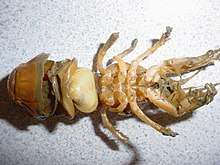Neaeromya rugifera
Neaeromya rugifera is a species of bivalve that inhabits the West Coast of North America.[1]
| Neaeromya rugifera | |
|---|---|
 | |
| Neaeromya rugifera on the underside of Upogebia pugettensis | |
| Scientific classification | |
| Kingdom: | Animalia |
| Phylum: | Mollusca |
| Class: | Bivalvia |
| Subclass: | Heterodonta |
| Order: | Galeommatida |
| Family: | Lasaeidae |
| Genus: | Neaeromya |
| Species: | N. rugifera |
| Binomial name | |
| Neaeromya rugifera (Carpenter, 1864) | |
| Synonyms | |
| |
Description
Neaeromya rugifera is a species of symbiotic bivalve that can be found on the abdomen of Upogebia pugettensis and on the ventral surface of Aphrodita, a genus of polychaete worm. They can attach and detach themselves at will using their byssus.[2][3] The largest examples of the specie was found to be 6mm in length, 2.5mm in height, and 1.5mm in width. N. rugifera do possess teeth, but no chondrophore. One investigation of stomach contents found diatoms and protozoan.[3] Sexual dimorphism results in female N. rugifera being larger than their male counterparts.[3] Males can be found to reside in the mantle cavity of females.[2] A 2008 study found no evidence of N. rugifera causing weight loss in U. pugettensis.[4]
Distribution
Neaeromya rugifera is spread across the West Coast, from Kodiak, Alaska, to Punta Rompiente, Baja California.
References
- "WoRMS - World Register of Marine Species - Neaeromya rugifera (Carpenter, 1864)". www.marinespecies.org. Retrieved 2020-02-12.
- "Pseudopythina rugifera". inverts.wallawalla.edu. Retrieved 2020-02-12.
- California Malacozoological Society; Society, California Malacozoological; Club, Northern California Malacozoological (1969–1970). The veliger. v.12 (1969-1970). Berkeley, CA :: California Malacozoological Society.CS1 maint: extra punctuation (link) CS1 maint: date format (link)
- Smith, Andrew E., John W. Chapman, and Brett R. Dumbauld (2008). "Population structure and energetics of the bopyrid isopod parasite Orthione griffinis in mud shrimp Upogebia pugettensis" (PDF). Journal of Crustacean Biology 28(2): 228-233.CS1 maint: multiple names: authors list (link)